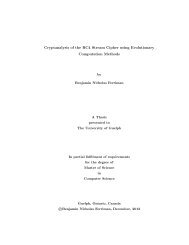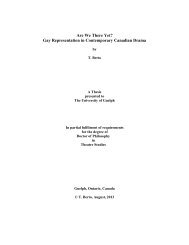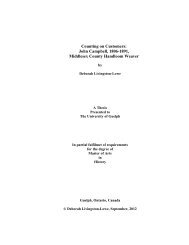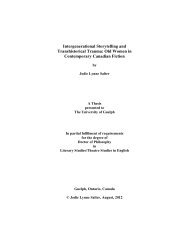THESIS - ROC CH ... - FINAL - resubmission.pdf - University of Guelph
THESIS - ROC CH ... - FINAL - resubmission.pdf - University of Guelph
THESIS - ROC CH ... - FINAL - resubmission.pdf - University of Guelph
Create successful ePaper yourself
Turn your PDF publications into a flip-book with our unique Google optimized e-Paper software.
sheets (Marques et al. 2006). Due to the presence <strong>of</strong> TiO2, cellulose-cellulose interactions were<br />
reported to decrease. This alleviates a major obstacle found in the present extrusion <strong>of</strong> SPI with<br />
cellulose fibers; the formation <strong>of</strong> aggregated cellulose fibers. As described in Section 6.0,<br />
aggregation can be promoted during aging and extrusion. By interfering with cellulose-cellulose<br />
interactions, fibers could remain separate so that interactions between cellulose and SPI can<br />
increase. More importantly, eliminating aggregation would aid in dispersion <strong>of</strong> the fibers<br />
spreading load concentrations upon tension. However this is only speculation and further study<br />
is required. Of note is that the maximum tensile strength with using Ti-coupled cellulose fibers<br />
still only equated the improvements seen with using 0.25% w/wSPI <strong>of</strong> either cellulose or TiO2<br />
separately. As such, other forces may be present in influencing the increase in strength<br />
observed.<br />
7.4.4 CONCLUSION<br />
This experiment showed that the addition <strong>of</strong> TiO2 nanoparticles alone resulted in<br />
mechanical improvements <strong>of</strong> base SPI film. Comparing different particle sizes, the optimal<br />
concentration for maximum tensile strength was found to be greater (0.5% w/w TIO 2/SPI) for the<br />
larger (21nm) P25 particle, and fewer (0.25% w/w TiO2/SPI) for the smaller (14nm) P90 particle.<br />
When coupled with extracted soy fibers, a synergistic trend was observed. At 0.25% w/w<br />
P90/SPI, a positive correlation was found for fiber addition and mechanical strength. However, it<br />
must be noted that the maximum strength increase was not more significant than the addition <strong>of</strong><br />
cellulose fibers alone. Nonetheless, TiO2 coupling highlights the potential for further fiber<br />
incorporation to further improve SPI/cellulose blend films. Future investigations may benefit<br />
from exploring the optimal ratio between TiO2 and cellulose fibers for use in aiding dispersion<br />
which was believed to be the critical factor in the synergistic effects observed.<br />
106

















